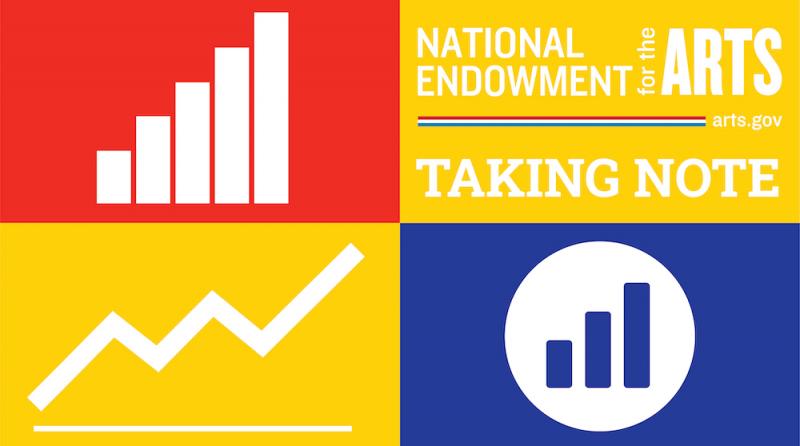Taking Note: The Social Determinants of Arts Engagement

Last week, researchers posted an article titled “Who engages in the arts in the United States?” The analysis is part of a long-term project by the NEA Research Lab at the University of Florida’s Center for Arts in Medicine. The Lab is analyzing several U.S. longitudinal datasets that include variables about the arts and health, so researchers better can understand the relationships between arts participation and positive health outcomes.
The article opens with the sentence: “Engaging in the arts is a health-related behavior that may be influenced by social inequalities.” The first half of that statement is justifiably cautious (“health-related” can be argued more persuasively than “health-promoting” can). For the second half, there is less reason to be tentative. For years if not decades, arts funders and policy-makers have wrestled with what might be called—by strong-arming public health jargon—the social determinants of arts engagement.
In this country, large datasets have shown repeatedly how demographic and socioeconomic factors can influence arts participation patterns. Studies such as the NEA’s Survey of Public Participation in the Arts not only report imbalances in terms of U.S. subgroups who engage with different art forms and activities; more fundamentally, these data have singled out educational status as the best across-the-board predictor of arts participation.
And yet, it’s not so simple. Depending on the type of art form or activity, differences in race and ethnicity, gender, and urbanicity can play an independent role in determining whether and how often people are likely to participate in the arts. (As predictors of arts participation, education and income are highly correlated.) Apart from demographic or socioeconomic variables, distinct motives for participating in arts activities—and perceived barriers to engagement—must be factored in.
As arts organizations look to re-engage more effectively with their communities post-pandemic, it is useful to review common motivations and barriers affecting arts engagement. Just last year, the NEA reported that non-whites and members of minority racial/ethnic groups were significantly more likely than non-Hispanic whites to report, in 2016, “celebrating [their] cultural heritage” as a reason for attending arts events or for making their own art. Over the same period, low-income groups typically cited cost and the difficulty of getting to the venue as key barriers to attending arts events. Younger adults (those born after 1997) more often reported the inability to find “someone to go with” as a key barrier.
Apart from understanding these needs on behalf of different subgroups, we all can benefit from knowing how others rate the presence of arts opportunities in daily life. In 2017, 65 percent of adults agreed with the statement, “There are plenty of opportunities to take part in arts and cultural activities in my neighborhood or community.” But fewer Blacks and Hispanics than Whites and Asians agreed with this and two related statements. Similarly, fewer Blacks agreed with the statement, “There are many different kinds of arts and cultural activities in my neighborhood or community,” compared with other racial/ethnic groups.
So, going back to the research article that posted last week, what did it reveal? In their exploratory analysis, Jessica Bone, University College of London (UCL), and her colleagues pooled General Social Survey data from 1993 to 2016. Over this timeframe, the survey has captured information about three broad types of arts engagement in the U.S.: attending arts events; creating or performing art; and holding membership in arts or cultural groups. As with previous studies, Bone et al. found that education—both of the survey respondents and their parents—was positively linked with all types of arts engagement. So was gender; that is, women were consistently more likely to engage than men were.
Other factors such as income, urbanicity, and self-reported social class and self-reported health status, were positively linked to attendance at arts events, but were not associated with the other two broad types of arts engagement. The UCL and U-Florida researchers also note that “the racial disparity in event attendance, with fewer participants of racial/ethnic minorities attending events than White participants, increased from 1993 to 2016.” This growing gulf appeared “independent of other socioeconomic factors,” Bone et al. add. They warn, however, that inconsistent measures of arts attendance had been used across the survey years.
As arts organizations look to reopen safely, it remains unknown whether that their virtual arts engagement strategies during COVID-19 will translate to larger and more diverse audiences than have participated through more traditional venues. Last November, a separate UCL research article examined how arts participation patterns may have changed during the pandemic. The researchers, including Daisy Fancourt—who works with U-Florida as part of the NEA Research Lab—analyzed data from the UK COVID-19 Study.
Questions about arts engagement formed a distinct module of the online survey. They were fielded in May 2020, ultimately capturing data on 19,384 adults. The survey identified four broad types of “home-based arts engagement” activity during the pandemic: digital arts and writing; performing arts; crafts; and reading for pleasure.
“Overall, our study suggests that some people who engaged in the arts during the COVID-19 pandemic were those who typically engage under normal circumstances,” the researchers write. At the same time, “younger adults (aged 18-29), non-keyworkers [i.e., non-essential workers], people with greater social support, and those with a trait emotion-focused copying style”—a variable recorded by the survey—“were more likely to have increased arts engagement during lockdown.”
The term “reset” is often used to describe the aspirations of the arts and cultural sector in finding new ways to operate when public health conditions normalize. A common theme in these discussions has been to honor and reinforce different cultural traditions—and methods of arts participation—while innovating practices (often through digital technology) to broaden and enrich arts opportunities for everyone. These needs are consonant with the NEA’s mission and vision, and they seem never more urgent than today.
Sunil Iyengar is the Director of the National Endowment for the Arts Office of Research and Analysis.




